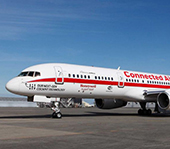Flightplan Broadcast Kickstarts Aviation’s Post-Covid Flightback
All industries have been dealt a series of severe blows by the current Covid-19 pandemic. Aviation has suffered more than most. That’s why at a time of stasis and disorientation, Inmarsat Aviation joined forces with APEX to develop FlightPlan, a unique one-day online broadcast that looked to connect the industry in lieu of the many cancelled aviation events.
Held at the end of April, more than 3,000 people watched FlightPlan live from almost 100 countries worldwide, with thousands more expected to catch-up on demand in the coming weeks. The average view time was 144 minutes, showing deep engagement, and the event also facilitated more than 100 meetings in the virtual networking area, making it a clear and resounding success.
Industry experts and analysts came from the likes of Airbus, Air Transport Action Group, Avianca, Collins Aerospace, Deutsche Telekom, European Space Agency (ESA), Honeywell, IATA, Japan Airlines, Panasonic Avionics and Rolls-Royce
Inmarsat Aviation Vice President Dominic Walters hosted the event and described the response as phenomenal. “Together, more than 50 leading voices shared a clear message,” he stated. “That while the aviation industry contends with a period of extreme uncertainty, these clouds will eventually clear. Now is the time to focus on accelerating our recovery and rebuilding an industry that is stronger, more agile and fit for the future.”
The feedback from viewers was universally positive too. “Thank you for inspiring us, and help us love again our jobs in this difficult quarantine times. Great team work,” wrote Gonzalo Monterrosa, flight dispatcher at Crossracer. “Great to see the industry stalwarts in one platform, sharing their thoughts for charting a turbulent free post COVID-19. Well done Team FlightPlan,” added Kuwait Airways’ Pradeep Gangadharan. “Thank you so much to everyone that worked on this broadcast,” concluded Saudi Arabian Airlines’ Sultan Asiri.
The event is now available to watch online and below are the highlights
The FlightPlan online broadcast event hosted by Inmarsat, in collaboration with APEX, saw over 3,000 people from across 100 countries tune in to watch over 50 industry professionals exchange views on the present and future of aviation.
The FlightPlan online broadcast event hosted by Inmarsat in collaboration with APEX covered a wide range of topics throughout the day, related to COVID-19 and beyond, but a highlight was “The Great Wi-Fi Debate,” which involved a discussion about the long-term future of in-flight connectivity.
During the session, CEO of Fast Future Rohit Talwar presented new findings from a research study his company is undertaking together with Future Travel Experience (FTE), “Future Air Transport Strategies and Technologies,” about what the passenger experience will look like by 2035. While the full study won’t be released until the end of the summer, Talwar said 88% of respondents predicted that airlines would be offering free in-flight Wi-Fi.
The feasibility of free IFC was then addressed by different participants throughout the segment. Nathan Clapton, VP Inflight Media at Inmarsat Aviation, said that passengers are happy to “pay” for their Wi-Fi by offering up their data, which is worth more than covering the cost of connectivity. He further argued that free Wi-Fi acts as an “engagement driver,” that through their portals, “airlines can provide all kinds of contextual products and services, refresh and increase ancillary revenues and make passengers more loyal over time.”
Rory Sutherland, vice-chairman of Ogilvy, took a different stance. “The second you make in-flight Wi-Fi free; it goes from being a perk to an expectation. At the very least, have differential pricing for faster or slower Wi-Fi,” he said. Instead, Sutherland listed the different ways that airlines could use the offer of Wi-Fi, suggesting, “You could use it for yield management. If there’s a less popular flight at a less fashionable time of day, you could advertise free Wi-Fi to get people to shift from an overbooked flight to an under-booked flight without using a price incentive.”
Sutherland also said that airlines could offer a Wi-Fi plan not just for a number of hours, but for one or two years: “What you’ve created is like easyJet Plus or Amazon Prime, a kind of loyalty scheme.” Another idea was to bundle Wi-Fi in with checked baggage, or with other ancillary revenue streams, such as extra-legroom seats. “Not charging for it is OK, but giving it away for free is a different matter. Don’t do that,” he implored.
Another response from Fast Future and FTE’s research study showed that by 2035, passengers expect to see the option for mass-customization in the cabin, both in terms of their seating environment (67%) and their broader cabin experience (66%).
IFC undoubtedly comes into the mix here. Airlines have the task of catering to a host of different passengers, as evidenced by aviation analyst Alex Macheras outlining the needs of Generation Z and Alexis Hickox suggesting more needed to be done to accommodate millennial parents traveling with Generation Alpha children, perhaps in the form of multi-user, multi-device Wi-Fi packages for families. However, for David Fox, VP Inflight Services and Connectivity at Deutsche Telekom, the need for seamless access to IFC overrides the necessity for access to a range of different bundles and plans.
“If you make it seamless, you can’t give the customer a whole host of tariffs,” Fox said. He used the example of roaming data in Europe, explaining that in the past, people had a certain data/minutes bundle, but knew that when they crossed the border to another country, they would be charged excessive rates on everything. Fox said the result was that people simply switched off their roaming capability.
“You could advertise free Wi-Fi to get people to shift from an overbooked flight to an under-booked flight without using a price incentive.” – Rory Sutherland, Ogilvy
“We changed that over to a system where you could buy a fixed price pass that would give people access to a certain number of MB/GB,” he continued. “What happened was that customer behavior changed from fear about their bills to a complete overview … we drastically slashed prices, but because so many more people were using it, we were more than overcompensating for our revenues. This is something that can be transferred 1:1 over to the airline industry.”
In fact, Fox revealed that from May, European Deutsche Telekom customers will be able to access the FlyNet service offered across Lufthansa Group’s European routes free of charge as part of their subscription bundle. “This will drive take rates and really increase passenger satisfaction,” he concluded.
While FlightPlan highlighted a range of different opinions on how to go about best leveraging IFC, this is clear: FlightPlan’s “Great Wi-Fi Debate” continued to underline the industry-wide consensus that connectivity will remain a key aspect of airlines’ brand differentiation, passenger experience, loyalty and ancillary revenue strategies for years to come.
Honeywell Completes JetWave System Testing For China
Honeywell (NYSE: HON) completed ground testing and flight testing of the JetWave connectivity system in China on its world-famous Boeing 757. This is a major milestone for Honeywell that will greatly increase its support of China’s in-flight, high-speed satellite communication.
Based on proven performance and recognition in the market, JetWave is designed for the China’s Ka-band satellite network. It provides reliable and high-speed cabin connectivity. JetWave has speeds of up to 180 Mbps, so passengers can expect the same high-speed Wi-Fi experience at 40,000 feet as they do on the ground, fully meeting business and entertainment connection demands.
Chinese operators with JetWave can bring better flight experiences to their passengers through access to high-speed internet, further increasing their competitiveness in the global aviation market and increasing their profitability. On top of the passenger benefits, JetWave also brings greater connectivity to assist maintenance operators and flight operations better manage aircraft, reduce fuel costs, and help avoid aircraft delays.
Honeywell’s JetWave satellite communications terminals provide a seamless, in-flight Ka-band service available worldwide. The hardware and network are optimized to work during flight, providing outstanding connectivity and enhancing the passenger experience.
In March 2019, Honeywell announced the appointment of Air Esurfing as the sole distributor of JetWave in China.
OneWeb successfully launches 34 more satellites into orbit
- OneWeb declares the launch and contact of its satellites successful today
- This launch continues path towards internet everywhere for everyone
- OneWeb is proud to launch from Kazakhstan, extending Baikonur Cosmodrome’s world-class legacy to the space industry
London, UK, 7 February 2020: OneWeb, the global communications company with a mission to bring connectivity to everyone everywhere, today announced the successful launch of 34 satellites, aboard a Soyuz launch vehicle from the historic Baikonur Cosmodrome, Kazakhstan.
Lift-off occurred on February 06th at 21:42 pm UTC. The OneWeb satellites separated from the rocket and were dispensed in nine batches over a period of several hours, with signal acquisition on all 34 confirmed within hours.
This launch is the second successful launch in one of the largest civilian satellite launch campaigns in history. It will help build OneWeb’s phase one constellation of 648 satellites that will deliver high-speed, low-latency global connectivity, while addressing the world’s most pressing connectivity problems.
The communications company is on schedule to provide global coverage to customers in 2021, starting with the first commercial services in the Arctic this year. This follows OneWeb both securing global priority spectrum rights and successfully launching its first batch of satellites in 2019.
OneWeb’s network will provide a unique combination of high data throughput, low latency, true global coverage and a range of user terminals for multiple markets including maritime, aviation, government and enterprise.
Adrian Steckel, CEO of OneWeb, said: “The successful manufacture, delivery and launch of this batch of 34 satellites is the latest proof point of the OneWeb plan. Importantly, today’s mission also brings us closer to our next step, realizing our ultimate vision of providing access to high speed, reliable internet to everyone, everywhere.
“We are seeing considerable interest from prospective customers and partners. Later this year, we will provide service in the arctic region and 2021 will see OneWeb achieve global coverage, making the digital divide a thing of the past. I’m very proud of our team and partners who continue to collaborate to make our ambitious scale a reality, and also those in Kazakhstan for supporting our vision.”
OneWeb sets launch date for high-speed broadband network
This event marks the start of a regular launch campaign taking place during 2020 that will rapidly grow OneWeb’s first-phase constellation of 648 satellites and represents one of the largest civilian satellite launch campaigns in history. Each satellite will be an integral part of the OneWeb high-speed global satellite broadband network, and together they will activate OneWeb’s first customer demos by the end of 2020 to provide full commercial global services, with aviation, as well as sectors such as maritime, government and enterprise following in 2021.
In this first launch of 2020, 34 satellites will be aboard a Soyuz launch vehicle. Launch service provider, Arianespace will perform the launch, which will place the satellites into a near polar orbit at an initial altitude of 450km (280 miles) from where they will rise to their final orbit of 1,200km (746 miles) and form part of OneWeb’s global communications network. All the satellites are manufactured by OneWeb Satellites, a joint venture between OneWeb and Airbus Defence and Space.
OneWeb has chosen the theme Space for Everyone for the first event in its 2020 launch programme, to demonstrate how space is becoming more relevant to everyday life as an important source of connectivity.
Gilat Achieves Fastest Ever Modem Speeds of 1.2 Gbps Total Throughput over Telesat’s Phase 1 LEO Satellite
Petah Tikva, Israel, November 21, 2019 — Gilat Satellite Networks Ltd. (NASDAQ, TASE: GILT), a worldwide leader in satellite networking technology, solutions and services, announced today that Gilat achieved the fastest ever modem speeds of 1.2 Gbps total throughput over Telesat’s Phase 1 LEO satellite. This industry milestone demonstrates the potential of high throughput Non-Geostationary Orbit (NGSO) satellite constellations. Gilat’s technology opens opportunities for new telecommunications products and a wider range of customer experiences to markets demanding very high throughputs such as cruise ships, large airplanes, trunking and high-capacity government applications. Additionally, the combination of high throughput provided by Gilat’s innovative technology and the low latency from NGSO creates opportunity for delay-sensitive applications such as 5G.
“Telesat is delivering on the promise of exceptional throughput, high data rate, low latency applications and this demonstration highlights the benefits of our LEO constellation architecture,” said Michel Forest, Director of Systems Engineering for the LEO Program at Telesat. “Telesat truly values our longstanding collaboration with Gilat and we are pleased to have achieved these remarkable levels of performance using Gilat’s innovative technology.”
“The strong partnership between Telesat and Gilat marks another outstanding achievement for delivery of next generation satellite services required for high-throughput applications,” said Amir Yafe, Head of Global Accounts at Gilat. “Demonstrating the industry’s fastest modem marks a significant breakthrough and a major milestone in realizing Gilat’s vision of enabling plentiful, quality and affordable broadband, by bringing innovative technologies that maximize the promise of NGSO satellite constellations.”
About Gilat
Gilat Satellite Networks Ltd. (NASDAQ: GILT, TASE: GILT) is a leading global provider of satellite-based broadband communications. With 30 years of experience, we design and manufacture cutting-edge ground segment equipment, and provide comprehensive solutions and end-to-end services, powered by our innovative technology. Delivering high value competitive solutions, our portfolio comprises of a cloud based VSAT network platform, high-speed modems, high performance on-the-move antennas and high efficiency, high power Solid State Amplifiers (SSPA) and Block Upconverters (BUC).
Gilat’s comprehensive solutions support multiple applications with a full portfolio of products to address key applications including broadband access, cellular backhaul, enterprise, in-flight connectivity, maritime, trains, defense and public safety, all while meeting the most stringent service level requirements. Gilat controlling shareholders are the FIMI Private Equity Funds. For more information, please visit: www.gilat.com
Certain statements made herein that are not historical are forward-looking within the meaning of the Private Securities Litigation Reform Act of 1995. The words “estimate”, “project”, “intend”, “expect”, “believe” and similar expressions are intended to identify forward-looking statements. These forward-looking statements involve known and unknown risks and uncertainties. Many factors could cause the actual results, performance or achievements of Gilat to be materially different from any future results, performance or achievements that may be expressed or implied by such forward-looking statements, including, among others, changes in general economic and business conditions, inability to maintain market acceptance to Gilat’s products, inability to timely develop and introduce new technologies, products and applications, rapid changes in the market for Gilat’s products, loss of market share and pressure on prices resulting from competition, introduction of competing products by other companies, inability to manage growth and expansion, loss of key OEM partners, inability to attract and retain qualified personnel, inability to protect the Company’s proprietary technology and risks associated with Gilat’s international operations and its location in Israel. We undertake no obligation to update or revise any forward-looking statements for any reason. For additional information regarding these and other risks and uncertainties associated with Gilat’s business, reference is made to Gilat’s reports filed from time to time with the Securities and Exchange Commission.






